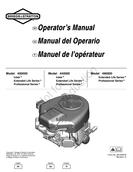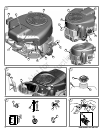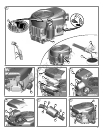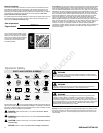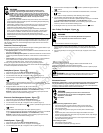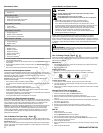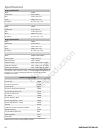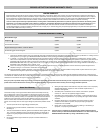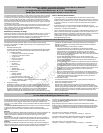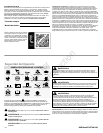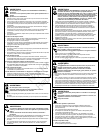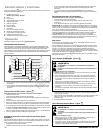
7
en
POISONOUS GAS HAZARD. Engine exhaust contains carbon
monoxide, a poisonous gas that could kill you in minutes. You
CANNOT see it, smell it, or taste it. Even if you do not smell exhaust
fumes, you could still be exposed to carbon monoxide gas. If you start
to feel sick, dizzy, or weak while using this product, shut it off and get
to fresh air RIGHT AWAY. See a doctor. You may have carbon
monoxide poisoning.
WARNING
Operate this product ONLY outside far away from windows, doors and vents to
reduce therisk of carbonmonoxide gas fromaccumulating and potentiallybeing
drawn towards occupied spaces.
Install battery--operated carbon monoxide alarms or plug--in carbon monoxide
alarms with battery back-up according to the manufacturer’s instructions.
Smoke alarms cannot detect carbon monoxide gas.
DO NOT run this product inside homes, garages, basements, crawlspaces,
sheds, or other partially-enclosed spaces even if using fans or opening doors
and windows for ventilation. Carbon monoxide can quickly build up in these
spaces and can linger for hours, even after this product has shut off.
ALWAYS place this product downwind and point the engine exhaust away from
occupied spaces.
NOTICE: This engine was shipped from Briggs & Stratton without oil. Before you start
the engine, make sure you add oil according to the instructions in this manual. If you
start the engine without oil, it will be damaged beyond repair and will not becovered
under warranty.
Determine The Starting System
Before startingthe engine, youmust determinethe type of starting systemthat ison your
engine. Your engine will have oneof the following types.
ReadyStart
®
System: This features a temperature controlled automatic choke. This
type does not have a primer.
Electronic Fuel ManagementSystem: This features an Electronic Control Unit that
monitors engine and temperature conditions. It does not have a manual choke or a
primer.
Choke System: This features a choke to be used for starting in cooltemperatures.
Some models will have a separate choke control while others will have a
combination choke/throttle control. This type does not have a primer.
To start your engine, follow the instructions for your type of starting system.
Note: Some engines and equipment have remote controls. See the equipment manual
for location and operation of remote controls.
ReadyStart
®
System - Figure
4
1. Check the oil level. See the How To Check/Add Oil section.
2. Make sure equipment drive controls, if equipped, are disengaged.
3. Turn the fuel shut -off valve (A), if equipped, to the on position (Figure 4).
4. Move the throttlec ontrol (B)tothefast
position. Operate the enginein the fast
position.
Note: For starting in cold temperatures (below 32 F), move the combination
choke/throttle lever (B, C) to the choke position. As the engine warms up, movethe
lever to the run position.
5. Engage the electric start switch, key (D) or push button (E).
NOTE: If the engine does not start after repeated attempts, contact your local dealer
or go to BRIGGSandSTRATTON.COM or call 1-800-233-3723 (in USA).
NOTICE: To extend the life of the starter, use short starting cycles (five seconds
maximum). Wait one minute between starting cycles.
Electronic Fuel Management System - Figure
4
1. Check the oil level. See the How To Check/Add Oil section.
2. Make sure equipment drive controls, if equipped, are disengaged.
3. Turn the fuel shut -off valve (A), if equipped, to the on position (Figure 4).
4. Move the throttlec ontrol (B)tothefast
position. Operate the enginein the fast
position.
5. Turn the electric start switch (D) to the on/start position (Figure 4).
NOTE: If the engine does not start after repeated attempts, contact your local dealer
or go to BRIGGSandSTRATTON.COM or call 1-800-233-3723 (in USA).
NOTICE: To extend the life of the starter, use short starting cycles (five seconds
maximum). Wait one minute between starting cycles.
Choke System - Figure
4
1. Check the oil level. See the How To Check/Add Oil section.
2. Make sure equipment drive controls, if equipped, are disengaged.
3. Turn the fuel shut -off valve (A), if equipped, to the on position (Figure 4).
4. Move the throttlec ontrol (B)tothefast
position. Operate the enginein the fast
position.
5. Move the choke control (C), or the combination choke/throttle lever, to the choke
position.
Note: Choke is usually unnecessary when restarting a warm engine.
6. Turn the electric start switch (D) to the on/start position (Figure 4).
NOTE: If the engine does not start after repeated attempts, contact your local dealer
or go to BRIGGSandSTRATTON.COM or call 1-800-233-3723 (in USA).
NOTICE: To extend the life of the starter, use short starting cycles (five seconds
maximum). Wait one minute between starting cycles.
7. As the engine warms up, move the choke control (C)totherun
position.
How To Stop The Engine - Figure
4
WARNING
Fuel and its vapors are extremely flammable and explosive.
Fire or explosion can cause severe burns or death.
Do not choke the carburetor to stop engine.
1. Move the throttle control to the slow position. Turn the key switch (D) to the off
position (Figure 4). Remove the key and keep in a safe place out of the reach of
children.
2. After the engine stops, turn the fuel shut-off valve (A), if equipped, to the closed
position.
Maintenance
We recommend that you see any Briggs & Stratton Authorized Dealer for all
maintenance and service of the engine and engine parts.
NOTICE: All the components used to build this engine must remain in place for proper
operation.
WARNING: When performing maintenance that requires the unit to be
tipped, the fuel tank must be empty or fuel can leak out and result in afire or
explosion.
Emissions Control
Maintenance, replacement, orrepair of theemissions control devices and systems
may be performed by any off-road engine repair establishment or individual.
However, to obtain “no charge” emissions control service, the work must be performed
by a factory authorized dealer. See the Emissions Warranty.
Unintentional sparking can result in fire or electric shock.
Unintentional start-up can result in entanglement, traumatic
amputation, or laceration.
Fire hazard
WARNING
Before performing adjustments or repairs:
Disconnect the spark plug wire and keep it away from thespark plug.
Disconnect battery at negative terminal (only engines with electric start.)
Use only correct tools.
Do not tamper with governor spring, links or other parts to increaseengine
speed.
Replacement parts must be of the same design and installed in the same
position as the original parts. Other parts may notperform as well, may damage
the unit, and may result in injury.
Do not strike the flywheel with a hammer or hard object becauset he flywheel
may later shatter during operation.
When testing for spark:
Use approved spark plug tester.
Do not check for spark with spark plug removed.













